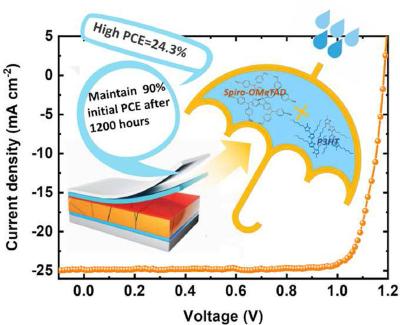Researchers from China's Chongqing University, the Chinese Academy of Sciences (CAS) and JA Solar Holdings Co., along with South Korea's Ulsan National Institute of Science and Technology (UNIST) and Germany's CTF Solar and have designed a perovskite solar cell based on a binary mixed hole transport layer (HTL) that reportedly offers better performance than HTLs that rely on commonly utilized hygroscopic dopants.
The team mixed two popular hole transport materials to form a binary mixed HTL, that exhibited improved moisture resistance. As a result, PSCs equipped with the mixed HTL achieved a champion power conversion efficiency (PCE) of up to 24.3% and superior operational stability. The cells without encapsulation can maintain 90% initial efficiency after storage in dark ambient conditions (30% RH) for 1200 hours. These results suggest that such a mixed HTL could be a promising strategy to meet the future photovoltaic applications demands with low-cost as well as excellent efficiency and device stability.
The scientists fabricated the HTL with the polymer Regioregular poly(3-hexylthiophene) (P3HT) and Spiro-OMeTAD in a mixed binary configuration, which they claim offers better protection to the perovskite absorber used in the cell thanks to the hydrophobicity of P3HT. “P3HT not only exhibits a higher degree of molecular order but also shows a preferential ‘face-on' orientation, i.e., the P3HT molecules are parallel to the substrate, which have significant positive effects on the opto-electronic properties and charge carrier mobility,” they explained.
The team built the solar cell with an indium tin oxide (ITO) substrate, a tin(IV) oxide (SnO2) electron transport layer (ETL), a perovskite layer, the proposed HTL, molybdenum oxide (MoOx) buffer layer, and a gold (Au) metal contact.
The researchers tested the performance of several solar cells developed with this design and with an active area of 0.08 cm2 through a solar simulator equipped with a 450 W Xenon lamp and a Keithley 2400 source meter under standard illumination conditions. The champion device achieved a power conversion efficiency of 24.30% and a certified efficiency of 24.22%. It also achieved an open-circuit voltage of 1.18 V, a short-circuit current density of 24.94 mA cm-2, and a fill factor of 82.51%. The cell was also able to retain 90% of its initial efficiency after 1,200 hours of storage in dark ambient environment.
“A successful modification of the conventional Spiro-OMeTAD HTL has been demonstrated by incorporating hydrophobic polymeric P3HT into Spiro-OMeTAD film to improve the efficiency and stability of perovskite solar cells,” the group concluded. “We believe that this strategy will pave the way on the development of low-cost, efficient and stable perovskite solar cells.”




